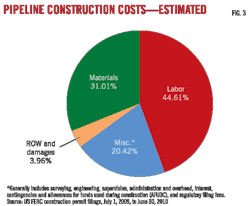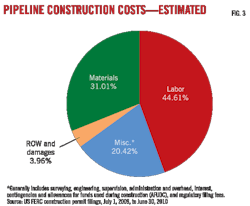Exploration is picking up in New Brunswick, which held its largest license offering earlier in 2010, and in Quebec in eastern Canada.
Only one oil field and one gas field produce in New Brunswick, but horizontal drilling and multistage fracturing that opened commercial production from shales in other basins are being tried on large acreage spreads.
This article summarizes recent exploratory drilling in New Brunswick and Quebec, including Anticosti Island, and excludes the busy Utica and Lorraine shale gas play in Quebec's St. Lawrence Lowlands.
Southwestern Energy program
Southwestern Energy Co., Houston, picked up 2,519,000 acres in the Maritimes basin along the Maritimes and Northeast Pipeline that brings natural gas to Canada and the Northeast US from fields on the Scotian shelf in the Atlantic.
But Steve Mueller, president and chief executive officer of Southwestern Energy, said the New Brunswick acreage could contain both an oil and gas window.
Southwestern said the main targets in New Brunswick are the conventional and unconventional sandstone and shale reservoirs of the Carboniferous Horton Group.
As of August, Southwestern was still at early days in exploring the province. It had flown gravity and magnetic surveys and was taking to the field to conduct surface geochem surveys to highgrade areas for seismic surveys. The first seismic surveys are likely to be shot in early 2011.
The licenses carry a $47 million work commitment in the initial 3-year exploration period and have options for multiple 5-year extensions. New Brunswick is Southwestern's first venture outside the US.
Apache and Corridor
Apache Corp., Houston, has a program to drill the B-41 and B-59 Green Road wells in the Elgin area under a farmout from Corridor Resources Inc., Halifax, NS.
Corridor in September said Apache has made good progress, having drilled the Apache-Corridor Green Road B-41 well as an offset to the vertical Green Road G-41 well that Corridor drilled in fall 2008 and hydraulically fractured in November 2009.
Corridor said Apache drilled the B-41 well along the bedding plane in the silty upper part of the Frederick Brook shale, encountering strong gas shows during drilling. Apache cased the well to total depth in preparation for multistage fracs later this fall in the 1,000-m lateral at 2,100 m true vertical depth.
Apache has moved the Nabors drilling rig 4 km southwest of the Green Road well to drill the Will DeMille M-59 shale gas appraisal well. It is to have a 1,000-m lateral at 2,400 m TVD.
M-59 is designed to offset an earlier well at Will DeMille drilled by Corridor and Columbia Natural Gas in 1999 that flared gas from the Frederick Brook formation during tripping operations. The lower part of the M-59 well will be drilled along the bedding plane in the Frederick Brook shale and cased in preparation for multistage fracs later this fall.
Corridor said Apache plans around five fracs in each well with 4,000 cu m of water and 300 tonnes of sand proppant sand per stage to be pumped at 16 cu m/min.
The Upper Frederick Brook is about 500 m thick on Corridor's acreage, and the Lower Frederick Brook is more than 600 m thick. Consulting engineers estimated 43 tcf in the upper zone and 24 tcf in place in the lower zone.
Triangle in Nova Scotia
Triangle Petroleum Corp., Denver, is seeking a partner to develop the 413,000-acre Windsor block in Nova Scotia east of McCully field.
Triangle said the block has more than 400 bcf/sq mile of measured, generated natural gas, which makes it a rich source system capable of yielding up to 20 tcf of resource, based on a 10% recovery factor.
The company has mapped a large conventional structure and brought it to drill-ready status, and the block also has an unconventional shale gas play that requires horizontal drilling and hydraulic fracturing.
McCully and Stoney Creek fields
Corridor said McCully field has 30 gas producing wells directionally drilled from 11 drill pads.
Almost no drilling has occurred in the field in 2009-2010, and Corridor noted that initial high decline rates have moderated to a more conventional decline. The company reworked three wells to stabilize and increase field production, resulting in a 30-day average uplift of 1.5 MMscfd.
The company is also adding a 2,400 hp compressor that is expected to boost delivery capacity to 45-50 MMcfd of gas.
McCully cumulative production is 28.9 bscf through May 2010, when the producing rate averaged 18.9 MMscfd from the Hiram Brook sands just above the Frederick Brook shale.
Stoney Creek oil field, developed south of Moncton, NB, with cable tools early last century, produced 800,000 bbl of 36° gravity oil until the late 1900s from an estimated 20 million bbl in place. The field, south of Southwestern's Cocagne block, also has natural gas potential.
Contact Exploration Inc., Calgary, a reconstituted public company, plans to horizontally redrill Stoney Creek field and also plans to exploit shale gas and coalbed methane on its eastern Canadian holdings.
Anticosti Island 2010 program
Corridor and Petrolia of Quebec released results of the three-well 2010 oil exploration program on Anticosti Island in the Gulf of St. Lawrence.
Corridor said that exploration results on Anticosti Island are so far disappointing but that the "presence of live oil shows and permeable reservoir development combined with the very large number of prospects are positive factors for future oil exploration on the island."
Corridor and Petrolia drilled three wells in mid-2010 to evaluate the oil potential of the Trenton/Black River and Mingan Group formations on the Jupiter, Chaloupe, and Saumon prospects in the central-east part of the island. All target formations are Ordovician in age.
Corridor reentered the Corridor/Hydro-Quebec Jupiter well and directionally deepened it to 2,038 m measured total depth in an attempt to encounter dolomitized and fractured carbonates in the Mingan and Romaine formations. The well encountered live oil shows in the Mingan formation but no significant reservoir potential and has been abandoned.
Petrolia as operator drilled the Chaloupe well to 1,639 m measured total depth with a subhorizontal leg in the Black River section. The well encountered only minor dolomitized carbonates with no apparent reservoir development.
Another key objective of this well was to core part of the oil-bearing Macasty shale overlying the Trenton formation. Approximately 27 m of conventional core were recovered and analysis of the reservoir character and fluid content of the core has commenced.
The oil-prospective Macasty shale, equivalent of the Utica shale, is present across virtually the entire island, with Corridor and Petrolia holding 900,000 and 600,000 net acres, respectively, in this emerging unconventional oil play.
Corridor and Petrolia are attempting to attract an knowledgeable shale oil player to farm into this play, and initial interest by several potential players has been strong due in part to the large area covered by this unconventional oil play. The deeper formations in the Chaloupe well were abandoned, with the upper section of the well being suspended for potential future shale oil related activities. Petrolia and Corridor each holds a 50% working interest in the Chaloupe well.
Corridor as operator drilled the Saumon well to 1,223 m measured total depth with a subhorizontal leg in the Black River section. The well encountered only minor dolomitized carbonates but had very permeable reservoir development in fractured Black River carbonates.
The Saumon well flowed a total of 47 cu m of salt water to surface, including an initial flow of 27 cu m (170 bbl) in the first 45 min. The high apparent reservoir permeability encountered, while water bearing in this well, is encouraging for future oil exploration in the area, Corridor said.
The deeper formations in the Saumon well have been abandoned, with the upper section of the well being suspended for potential future shale oil related activities. Working interests in the well are Corridor 75% and Petrolia 25%.
Meanwhile, a combine of Investcan Energy and Petrolia plans to develop the Haldimand light oil discovery in eastern Gaspe, Que., in shallow Devonian sandstones (OGJ Online, July 22, 2010).
More Oil & Gas Journal Current Issue Articles
More Oil & Gas Journal Archives Issue Articles
View Oil and Gas Articles on PennEnergy.com



